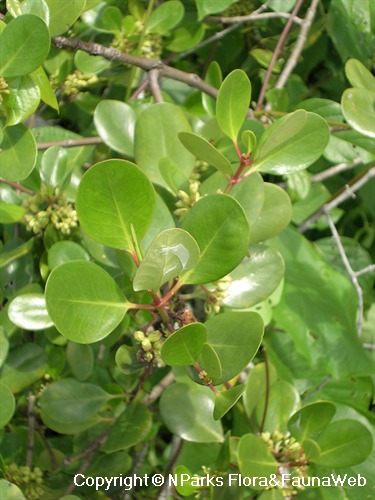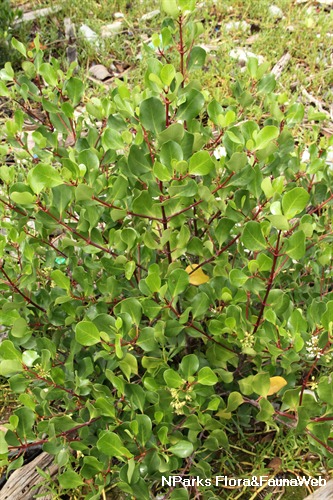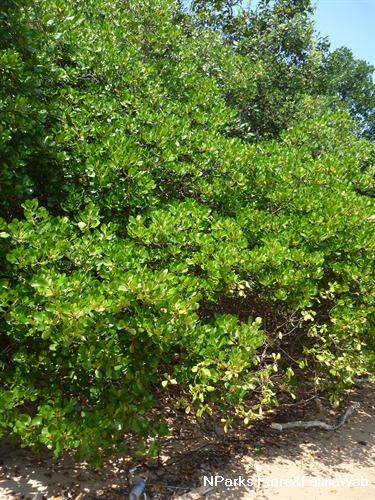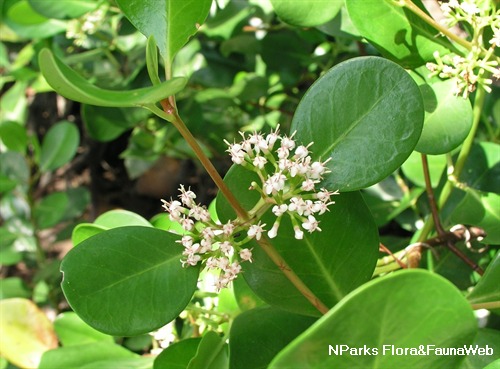
Back
Scyphiphora hydrophylacea C.F.Gaertn.
| Family Name: | Rubiaceae |
| Common Name: | Chengam, Chingam, Sebasah, 瓶花木 |
Name
Classifications and Characteristics
| Plant Division | Angiosperms (Flowering Seed Plants) (Dicotyledon) |
|---|---|
| Plant Growth Form | Shrub, Tree (Shrubby (1m-5m)) |
| Lifespan (in Singapore) | Perennial |
| Mode of Nutrition | Autotrophic |
| Plant Shape | Shrubby |
| Maximum Height | 6 m |
Biogeography
| Native Distribution | Coastal areas of east Madagascar , India to Australia (including the coasts of East India, Sri Lanka, Andaman Islands, South China, Vietnam, Cambodia, Sumatra, Peninsular Malaysia, Singapore, the Philippines, Borneo, New Guinea, Northeast Australia, Micronesia (Palau Islands), and Solomon Islands) |
|---|---|
| Native Habitat | Terrestrial (Coastal Forest), Shoreline (Mangrove Forest, Backshore, Sandy Beach) |
| Preferred Climate Zone | Tropical, Sub-Tropical / Monsoonal |
| Local Conservation Status | Native to Singapore (Endangered (EN)) |
Description and Ethnobotany
| Growth Form | It is a shrub or small tree up to 6 m tall, occasionally with small stilt roots, and brownish-grey bark. Its fruit is dispersed by water. |
|---|---|
| Foliage | Its opposite, stalked leaves have leathery blades that are usually drop-shaped to broadly elliptic with a rounded tip, light green, hairless on both sides, 4–7 by 2–4 cm, and have 4–6 pairs of veins that may be slightly visible or indistinct. |
| Flowers | Its flowers are pale pink to whitish-pink, 3–5 mm long, hairless outside, and arranged in 1.5–3 by 2–2.5 cm clusters. |
| Fruit | Its fruit is ellipsoid, green at first, turning yellow then shiny brown when mature, 8–10 by 4–5 mm, fleshy, hairless, have 6–10 longitudinal ridges, and consists of 2 parts with 2 seeds each. |
| Habitat | It grows in mangrove forests and coastal habitats. It occurs locally in Pulau Ubin (including Chek Jawa), Pulau Tekong (including Pulau Tekong Kechil and Pulau Unum), Sungei Pandan, Pulau Semakau, Pulau Pawai and other sites. |
| Associated Fauna | It is the preferred local food plant for caterpillars of the common tit butterfly (Hypolycaena erylus) and Eporectis tephropis. Its flowers are pollinated by birds. The adults of the common tit lay its eggs singly on leaves, stem or young shoots of the plant |
| Cultivation | It can be propagated by seed. |
| Etymology | Greek Scyphiphora, a two-handled cup, possibly referring to the stigma shape or the oblong fruit; Latin hydrophylacea, resembling the genus Hydrophyllum |
| Ethnobotanical Uses | Medicinal: An extract of the leaves could be used for stomachaches. Timber & Products: Its wood is hard and is used as timber for small objects. |
Landscaping Features
| Landscaping | It is suitable for coastal areas, as well as parks, around the edges of ponds and water bodies for its attractive foliage and scented flowers. |
|---|---|
| Desirable Plant Features | Ornamental Foliage, Fragrant |
| Landscape Uses | Coastal, Parks & Gardens, Beachfront / Shoreline, Pond / Lake / River, Marsh / Bog |
Fauna, Pollination and Dispersal
| Fauna Pollination Dispersal Associated Fauna | Butterfly Host Plant |
|---|---|
| Pollination Method(s) | Biotic (Fauna) |
| Seed or Spore Dispersal | Abiotic (Water) |
Plant Care and Propagation
| Light Preference | Full Sun |
|---|---|
| Water Preference | Moderate Water, Lots of Water |
| Plant Growth Rate | Moderate |
| Rootzone Tolerance | Moist Soils, Waterlogged Soils (Drains Site, Does not Drain Site), Well-Drained Soils, Fertile Loamy Soils |
| Propagation Method | Seed |
Foliar
| Foliage Retention | Evergreen |
|---|---|
| Mature Foliage Colour(s) | Green |
| Mature Foliage Texture(s) | Glossy / Shiny, Leathery |
| Foliar Type | Simple / Unifoliate |
| Foliar Arrangement Along Stem | Opposite |
| Foliar Attachment to Stem | Petiolate |
| Foliar Shape(s) | Non-Palm Foliage (Obovate, Elliptical) |
| Foliar Venation | Pinnate / Net |
| Foliar Margin | Entire |
| Foliar Apex - Tip | Rounded |
| Leaf Area Index (LAI) for Green Plot Ratio | 4.5 (Shrub & Groundcover - Dicot) |
Floral (Angiosperm)
| Flower & Plant Sexuality | Bisexual Flowers |
| Flower Colour(s) | White |
|---|---|
| Flower Grouping | Cluster / Inflorescence |
| Flower Location | Axillary |
| Flower Symmetry | Radial |
Fruit, Seed and Spore
| Mature Fruit Colour(s) | Brown |
|---|---|
| Fruit Classification | Simple Fruit |
| Fruit Type | Fleshy Fruit , Non-Accessory Fruit |
Image Repository
Others
| Master ID | 1151 |
|---|---|
| Species ID | 2444 |
| Flora Disclaimer | The information in this website has been compiled from reliable sources, such as reference works on medicinal plants. It is not a substitute for medical advice or treatment and NParks does not purport to provide any medical advice. Readers should always consult his/her physician before using or consuming a plant for medicinal purposes. |

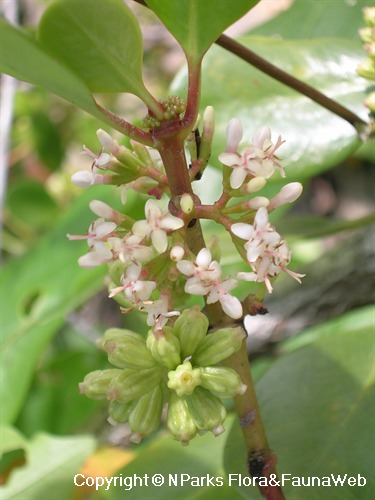
.jpg)
